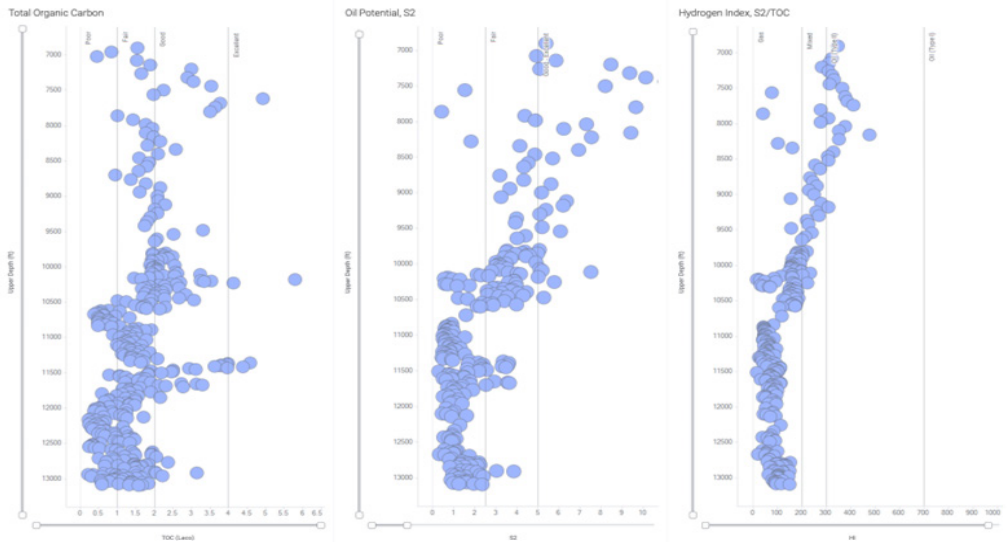Have any Questions?
GeoMark Research, Ltd.
9748 Whithorn Drive
Houston, Texas 77095
GeoMark Research, Ltd.
PREMIER SOURCE ROCK LABORATORY
SOURCE ROCK ANALYSIS
Overview
Source rock analysis is critical to your petroleum exploration success, both conventional and unconventional, as it helps characterize sedimentary organic matter and evaluate resource potential. GeoMark’s source rock laboratory, located in Humble, Texas, is one of the premier source rock laboratories in the oil and gas industry. With ten pyrolysis instruments, including Leco TOC, Rock Eval-II, Rock Eval-VI, SRA, and HAWK, we are equipped to handle any project in a timely manner. Our highly trained staff and dedication to following strict QA/QC procedures ensure accurate, reliable data that you can trust.
We Help Solve Your Biggest Challenges
- Defining source rock quality and extent
- Determining source rock maturity
- Evaluating source rock generative potential
- Identifying productive landing zones in resource plays
- Predicting fluid properties and trends
The GeoMark Research Advantage
Contamination – With the use of Oil Based Mud (OBM) and Synthetic Drilling Mud, it is essential that these contaminants are removed from the samples before analysis to avoid any misrepresentation of the results. GeoMark Research’s consultative nature provides contamination insights early into the analytical program to reduce unnecessary and spurious results by using a series of cleaning techniques to minimize impacts on customer projects. To minimize the impact of cavings and lost circulation material (LCM), our team is trained to identify and pick these particles from the sample set.
Total Organic Carbon (TOC) – LECO TOC and HAWK systems are utilized to determine TOC of each sample and therefore the identification of potential source rocks in the subsurface and outcrops.
Extraction – GeoMark Research offers several hydrocarbon extraction options to answer your specific project questions, dialing into different phases of hydrocarbon as needed. Extraction techniques help improve maturity estimates, predict GOR, and establish migration trends. We will advise on different options and also offer you the ability to customize solvent types upon request.
Pyrolysis – We provide assessments of free hydrocarbons in place (S1), remaining generative potential (S2) and thermal maturity (Tmax) of source rocks. You’ll have the option of utilizing either Rock-Eval™ or HAWK systems to collect this data as well as customized temperature profiles to better characterize S1 and predict produced fluid properties.
Vitrinite Reflectance – To further quantify the maximum burial of source rocks, GeoMark Research’s team of petrologists will work to isolate kerogen within the samples and work towards identifying kerogen type and thermal maturity. This data is used by our Basin Modelers to calibrate their depositional model.
Applications
Source rock analysis is typically performed when initially assessing the potential of an oil or gas field of interest. It helps guide your immediate and future drilling program decisions, by determining:
This information is used in development work to define landing zones, but also expands to exploration projects, as it helps confirm petroleum system source presence and maturity.

The low cost of source rock analysis makes it an ideal “screening” tool before committing to more expensive, detailed geochemical analyses, such as fingerprinting hydrocarbon extracts, SARA, biomarker analyses, and crushed shale (TruSat™) core evaluation. Whether analyzing cuttings, outcrops, core, or RSWC samples, GeoMark has the expertise to give you the answers you need.
HAWK-PAM Pyrogram

Source Rock Screening
- Organic richness/total organic content (TOC)
- Free hydrocarbons in place (S1)
- Remaining hydrocarbon potential (S2)
- Thermal maturity (Tmax)

Kerogen Typing
This process helps characterize source rock organic matter to understand quality and quantity. Such information is critical for modeling generated hydrocarbon and remaining potential. Higher resolution work yields more detailed facies models that correlate with reservoir characterization and other petroleum system risks.

Source Rock Mapping
As a GeoMark Research client, you have the option to combine your own source rock data with GeoMark’s ever-expanding Source Rock Database in order to leverage advanced data analytics and better understand hydrocarbon potential in the context of the surrounding play. This helps reduce time spent in evaluation and lend more.
